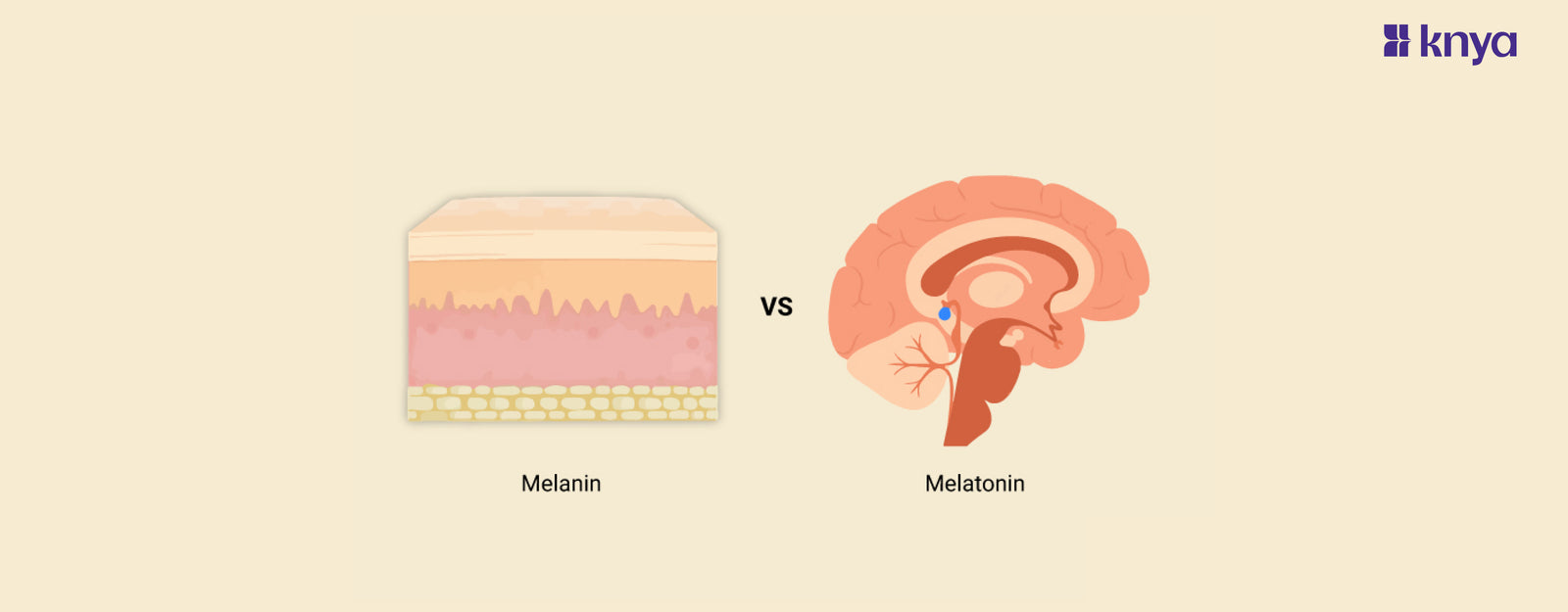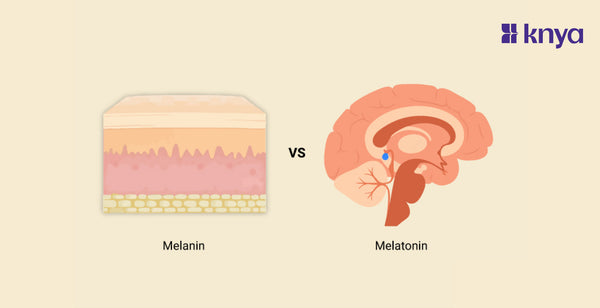Difference Between Melanin and Melatonin: In the intricate tapestry of human biology, the terms "melanin" and "melatonin" often spark curiosity due to their phonetic similarity. However, these compounds play distinct roles within the body, governing diverse functions that extend beyond their shared linguistic roots. Here, we unravel the differences between melanin and melatonin, shedding light on their individual significance:
Difference Between Melanin and Melatonin
Here's a comparison table highlighting the differences between melanin and melatonin:
|
Aspect |
Melanin |
Melatonin |
|
Function |
Pigment responsible for skin, hair, and eyes |
Hormone that regulates sleep-wake cycle |
|
Production Site |
Produced by melanocytes in skin, hair follicles, and eyes |
Synthesized by the pineal gland in the brain |
|
Color Influence |
Determines skin, hair, and eye color |
Does not influence coloration |
|
Protective Role |
Protects against UV radiation from the sun |
Not associated with protective functions |
|
Variants |
Eumelanin (brown/black), pheomelanin (red/yellow) |
No variants based on color |
|
Daily Rhythm |
No daily rhythm; constant presence |
Peaks during the night, influenced by darkness |
|
Light Sensitivity |
Not affected by exposure to light |
Production inhibited by exposure to light |
|
Sleep Regulation |
Not involved in sleep regulation |
Crucial for regulating sleep-wake cycles |
|
Synthesis Factors |
Influenced by genetics and UV exposure |
Affected by exposure to light and darkness |
What is Melanin?
Melanin is a complex biological pigment that is responsible for the coloration of various tissues in the body, including the skin, hair, and eyes. It is produced by specialized cells called melanocytes, which are primarily located in the epidermis (outer layer of the skin), hair follicles, eyes, inner ear, and certain other tissues.
Key features of melanin include:
- Pigmentation: Melanin imparts color to the skin, hair, and eyes. The variations in skin, hair, and eye color among individuals are primarily attributed to differences in melanin production and distribution.
- Protection against UV Radiation: One of the crucial functions of melanin is to provide protection against the harmful effects of ultraviolet (UV) radiation from the sun. It absorbs and scatters UV radiation, helping to prevent damage to DNA and other cellular structures.
- Types of Melanin: There are different types of melanin, with the two main forms being eumelanin and pheomelanin. Eumelanin is responsible for brown and black colors, while pheomelanin contributes to red and yellow hues.
- Genetic and Environmental Influence: The production and distribution of melanin are influenced by both genetic factors and environmental factors, such as exposure to sunlight. People with higher melanin levels tend to have a darker complexion.
- Hair and Eye Color: Melanin determines the color of hair and eyes. The concentration and type of melanin in hair follicles contribute to the color of hair, while the amount of melanin in the iris affects eye color.
- Role in Inner Ear: Melanin is also found in the inner ear, where it plays a role in protecting delicate structures and may contribute to hearing function.
While melanin is crucial for pigmentation and protection, variations in its production and distribution contribute to the rich diversity of human appearances. The study of melanin and its functions is important in fields such as dermatology, genetics, and evolutionary biology.
Check out Men's Long Lab Coat Apron
What is Melatonin?
Melatonin is a hormone produced by the pineal gland, a small pea-sized gland located in the brain. It plays a crucial role in regulating the sleep-wake cycle and other circadian rhythms in the body. The production and release of melatonin are influenced by the perception of light and darkness in the environment.
Key features of melatonin include:
- Circadian Rhythm Regulation: Melatonin is a central player in regulating the body's circadian rhythms, which are natural, internal processes that follow a roughly 24-hour cycle. It helps synchronize various physiological functions with the daily cycle of light and darkness.
- Synthesis in Darkness: The synthesis and release of melatonin are stimulated by darkness and inhibited by exposure to light. The pineal gland typically begins to produce melatonin in the evening as daylight diminishes, reaching peak levels during the night.
- Sleep Induction: Melatonin is often referred to as the "sleep hormone" because its increased levels in the bloodstream typically coincide with the onset of sleep. It signals to the body that it's time to wind down and prepare for rest.
- Antioxidant Properties: Melatonin possesses antioxidant properties, helping to neutralize free radicals in the body. This antioxidant activity is thought to contribute to its protective effects on various tissues.
- Jet Lag and Shift Work: Melatonin supplements are sometimes used to alleviate jet lag symptoms, as they can help reset the body's internal clock. Additionally, individuals who work night shifts or irregular hours may use melatonin to adjust their sleep-wake patterns.
- Influence on Seasonal Changes: Melatonin production can be influenced by seasonal changes in daylight exposure. This is believed to play a role in seasonal affective disorder (SAD) and other mood-related conditions.
- Interactions with Other Hormones: Melatonin interacts with other hormones and neurotransmitters, including serotonin. It is part of a complex system that regulates sleep, mood, and various physiological functions.
Melatonin supplements are available over-the-counter and are commonly used as a sleep aid, especially in cases of insomnia or jet lag. It's important to note that the use of melatonin supplements should be approached with caution, and consultation with a healthcare professional is recommended, particularly due to its potential interaction with other medications and individual variations in response.
Similarity Between Melanin and Melatonin
Despite their distinct functions and roles in the body, melanin and melatonin share some similarities:
- Biological Synthesis:
- Both melanin and melatonin are biologically synthesized compounds within the body.
- Derived from Amino Acids:
- Both compounds are derived from amino acids. Melanin is produced from the amino acid tyrosine, while melatonin is derived from tryptophan.
- Influence of Light and Darkness:
- The production and release of both melanin and melatonin are influenced by the perception of light and darkness. Melanin production is influenced by exposure to sunlight, while melatonin synthesis is stimulated by darkness and inhibited by exposure to light.
- Role in Protection:
- Melanin has a protective role against the harmful effects of ultraviolet (UV) radiation from the sun, providing a defense mechanism for the skin and other tissues. Melatonin, with its antioxidant properties, also contributes to protecting cells and tissues from oxidative stress.
- Involvement in Circadian Rhythms:
- While melanin primarily governs pigmentation, melatonin is a key player in regulating circadian rhythms, including the sleep-wake cycle. Both contribute to the overall balance and homeostasis of the body.
- Derived from Pineal Gland:
- Both melanin and melatonin have connections to the pineal gland. Melanin is not directly produced by the pineal gland but is influenced by it, especially in the context of skin pigmentation. Melatonin is synthesized and released by the pineal gland.
- Influence on Sleep Patterns:
- While their primary functions differ, both melanin and melatonin can indirectly influence sleep patterns. Melanin's role in protecting the skin from UV radiation allows for better sleep quality by preventing sun damage, while melatonin directly regulates the sleep-wake cycle.
While these similarities exist, it's crucial to emphasize their distinct functions and the diverse roles they play in maintaining various physiological processes within the body.
|
Check out More Articles |
|















